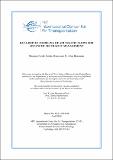Data-Driven Modeling of Air Traffic Flows for Advanced Air Traffic Management
Author(s)
Condé Rocha Murça, Mayara; Hansman, R. John
DownloadICAT-2019-04_Mayara_Data-Driven Modeling.pdf (25.59Mb)
Metadata
Show full item recordAbstract
The Air Traffic Management (ATM) system enables air transportation by ensuring a safe and
orderly air traffic flow. As the air transport demand has grown, ATM has become increasingly
challenging, resulting in high levels of congestion, flight delays and environmental impacts.
To sustain the industry growth foreseen and enable more efficient air travel, it is important to
develop mechanisms for better understanding and predicting the air traffic flow behavior and
performance in order to assist human decision-makers to deliver improved airspace design and
traffic management solutions. This thesis presents a data-driven approach to modeling air
traffic flows and analyzes its contribution to supporting system level ATM decision-making.
A data analytics framework is proposed for high-fidelity characterization of air traffic flows
from large-scale flight tracking data. The framework incorporates a multi-layer clustering
analysis to extract spatiotemporal patterns in aircraft movement towards the identification
of trajectory patterns and traffic flow patterns. The outcomes and potential impacts of this
framework are demonstrated with a detailed characterization of terminal area traffic flows
in three representative multi-airport (metroplex) systems of the global air transportation
system: New York, Hong Kong and Sao Paulo.
As a descriptive tool for systematic analysis of the flow behavior, the framework allows
for cross-metroplex comparisons of terminal airspace design, utilization and traffic performance.
Novel quantitative metrics are created to summarize metroplex efficiency, capacity
and predictability. The results reveal several structural, operational and performance differences
between the metroplexes analyzed and highlight varied action areas to improve air
traffic operations at these systems.
Finally, the knowledge derived from flight trajectory data analytics is leveraged to develop
predictive and prescriptive models for metroplex configuration and capacity planning
decision support. Supervised learning methods are used to create prediction models capable
of translating weather forecasts into probabilistic forecasts of the metroplex traffic flow
structure and airport capacity for strategic time horizons. To process these capacity forecasts
and assist the design of traffic flow management strategies, a new optimization model
for capacity allocation is developed. The proposed models are found to outperform currently
used methods in predicting throughput performance at the New York airports. Moreover,
when used to prescribe optimal Airport Acceptance Rates in Ground Delay Programs, an
overall delay reduction of up to 9.7% is achieved.
Date issued
2019-04-26Series/Report no.
;ICAT-2019-04